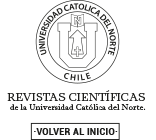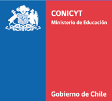La cosecha inoportuna, transhumancia y el proceso de domesticación
DOI:
https://doi.org/10.22199/S07181043.1975.0003.00010Resumen
Las estructuras que controlan las características de las cosechas son de suma importancia en la domesticación y mejoramiento de muchas plantas. La periodización imperfecta de las cosechas, que es una característica esencial de la caza y recolección transhumante, ejerce una fuerte presión selectiva en los factores genéticos que controlan las características de la maduración y cosecha. Es más probable que las variantes genéticas fueron llevadas a hábitats nuevos bajo condiciones de transhumancia, en las serranías ecuatoriales. Los comienzos de la agricultura americana parecen coincidir con tales modos de vida en tiempo y espacio.
Citas
BEALS, E. W., 1969. Vegetational change along altitudinal gradients. Science 165: 981-985.
CLAUSE-N, J., D. D. KECK y V. M. HIFSEY, 1948. Experimental studies on the nature of species. III. Environmental Responses of Climatic Races of Achillea. Carnegie Institution of Washington, Publication 581.
COE, M. D. y K. V. FLANNERY, 1964. Microenvironments and Mesoamerican Prehistory. Science 143: 650-654.
DAVID, E. L., 1963. The Desert Culture of the Western Great Basin: A lifeway of seasonal transhumance. American Antiquity 29: 202-2012.
DEFFONTAINES, P., 1965. Transhumance et mouvements de bétail en Amérique latine. Les Cahiers d’Outre-Mer 18 (71): 258-291.
FLANNERY, K. V., 1965. The ecology of early food production in Mesopotamia. Science 147: 1217-1256.
GALINAT, W. C., 1971. The origin of maize. Annual Review of Genetics 5: 447-478.
GENTRY, H. S., 1969. Origin of the common bean, Phaseolus vulgaris. Economic Botany 23:55-69.
HARRIS, D. R., 1969. Agricultural systems, ecosystems and the origins of agriculture. En The domestication of plants and animals, P. J. Ucko y B. W. Dimbleby (Eds.). Aldine, Chicago.
HAWKES J. G., 1969. The ecological background of plant domestication. En The domestication of plants and animals. P. J. Ucko y G. W. Dimbleby (Eds.). Aldine, Chicago.
HELBAEK, H., 1959. Domestication of food plants in the Old World. Science 130: 365-372.
LANNING, E. P., 1967. Peru before the Incas. Prentice-Hall, Englewood Cliffs.
LYNCH, T. F., 1967. The nature of the Central Andean Preceramic. Occasional Papers of the Idaho State University Museum 21, Pocatello.
----1971. Preceramic transhumance in the Callejon de Huaylas, Peru. American Antiquity 36: 139-148.
MACNEISH, R. S., 1964. Ancient Mesoamerican Civilization. Science 143: 531-537.
----1971. Speculation about how and why food production and village life developed in the Tehuacan Valley, Mexico. Archaeology 24: 307-315.
MANGELSDORF, P. C. y J. CAMARA-HERNANDEZ, 1967. Prehistoric maize front a site near Huarmey, Peru; Prehistoric maize from Huaca Prieta, Peru; Prehistoric maize from Ica Valley, Peru. Maize Genetics Cooperation Newsletter 41: 47-49.
MANGELSDORF, P., R. S. MACNEISH y W. C. GALINAT, 1964. Domestication of corn. Science 143: 538-545.
MOSELEY, M. 1972. Subsistence and demography: An example of interaction from prehistoric, Peru. Southwestern Journal of Anthropology 28: 25-49.
MURRA, J. V., 1968. An Aymara Kingdom in 1567. Ethnohistory 15: 115-151.
----1972. El “control vertical” de un máximo de pisos ecológicos en la economía de las sociedades andinas. En Visita a la provincia de León de Huanuco en 1562, vol. II. J. V. Murra (Ed.). Universidad Hermilio Valdizán, Huanuco.
NUÑEZ, L., 1971. Secuencia y cambio en los asentamientos humanos de la desembocadura del río Loa, en el norte de Chile. Boletín de la Universidad de Chile apartado 112.
NUÑEZ, L., L., V. ZLATAR y P. NUÑEZ, 1972 Ms. Reciente prospección de sitios arqueológicos componentes de un circuito transhumántico entre la costa y el borde occidental de la Pampa del Tamarugal.
PACKARD, F. M., 1945. The birds of Rocky Mountain National Park, Colorado. Auk 62: 371-394.
PATTERSON, T. C., 1971a. Central Peru: Its population and economy. Archaeology 24:316-321.
----1971b. The emergence of food production in Central Peru. En Prehistoric agriculture, S. Struever (Ed.). Natural History Press, Garden City.
PICKERSGILL, B., 1969. The archaeological record of Chili Peppers (Capsicum spp.) and the sequence of plant domestication in Peru. American Antiquity 34: 54-61.
----1972. Cultivated plants as evidence for cultural contacts. American Antiquity 37: 97-104.
TAKASHI, R. 1955. The origin and evolution of cultivated barley. Advances in Genetics 7: 227-266.
WEISS, P., 1957. Las zonas andinas de la patología del Phlebotomus. Perú Indígena 6: 46-55.
Cómo citar
Número
Sección

Todos los trabajos publicados en Revista Estudios Atacameños (eISSN:0718-1043) están sujetos a una licencia Creative Commons Reconocimiento 4.0 Internacional
Los autores continúan como propietarios de sus trabajos, y pueden volver a publicar sus artículos en otro medio sin tener que solicitar autorización, siempre y cuando indiquen que el trabajo fue publicado originariamente en Revista Estudios Atacameños (eISSN:0718-1043).

















